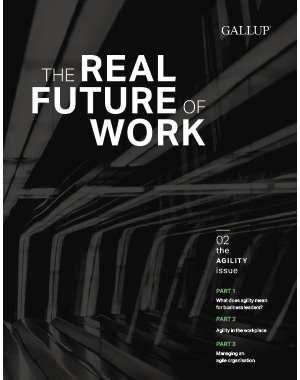Story Highlights
- The need for remote agile happened overnight amid the pandemic
- Build trust through relationships to combat anxiety in agile remote teams
- Focus on four key actions to bolster a successful new way of working
Many organizations had already been experimenting with -- or even scaling -- agile capabilities before the coronavirus outbreak. But none were ready for the abrupt shift to remote agile. Working remotely has transformed the global workforce.
In 2019, Gallup surveyed thousands of employees and found that only 36% of employees in the United Kingdom and France felt their company had an agile mindset.
One year later, during COVID-19, these figures have dropped to 26% in the U.K. and 28% in France. Clearly, organizations with employees who are working remotely are struggling to keep agile principles alive -- a problem that increases as does the proportion of remote work employees. A recent survey showed that 65% of British employees are working from home, compared with 59% in France.
The agile mindset is a precondition of the practices that enable customer-centric organizations to iterate swiftly to market new products and solutions based on ever-changing customer needs -- to be truly agile. Typically, agile teams work in a "war room" with ongoing, direct interaction, co-creating and communicating on the spot.
This promotes engagement and enables highly productive work environments, naturally increasing the likelihood of timely feedback -- and Gallup has found that employees in agile teams are twice as likely as others to say they receive feedback from their supervisors daily or several times a week.
And then the war room closed down.
That forced a new way of doing work -- remote agile -- in which teams must salvage the benefits of agile teaming structures (such as productivity and employee engagement) without the benefit of physical proximity. It can be done, but it requires focusing on four key actions.
-
Maximize the use of virtual collaboration tools for remote teams: Agile teams are efficient and productive because they "speak the same language" and use tools and workflows that enable their best work. Moving these teams to remote agile risks disrupting their flow and forcing them to leave their tools behind.
To avoid this, organizations moving to remote agile must be intentional about selecting a portfolio of tools that replicate the in-person work environment as closely as possible.
For instance, Kanban boards can be virtually replicated (thanks to tools like Asana and Jira) and manage backlogs equally well. Alternatively, tools like Mural or Shape by IDEO are particularly good at recreating a sense of real-time physical collaboration. Juggling multiple tools may seem difficult, but a single one is unlikely to accomplish what innovation luminary Clayton Christensen would call "jobs to be done."
Gallup has found that employees in agile teams are twice as likely as others to say they receive feedback from their supervisors daily or several times a week.
-
Replicate agile rituals while working remotely: Regardless of the environment, agile teams should stick to foundational agile rituals -- such as sprint retrospectives and daily stand-ups -- to prevent their work environment from hindering their effectiveness and to assist with engaging employees.
For example, daily stand-ups (status update meetings where everyone outlines progress made from the previous day, the planned tasks for the day and any barriers) done via conference call may cause less vocal team members to feel left out. That doesn't make them feel like their opinion counts -- which Gallup has identified as a key driver of employee engagement. Videoconferences or a simple roll call can prevent that, but ultimately the format doesn't matter. The principle does. Teams that are innovative to the core should be able to find a way to transpose their rituals to a new way of remote work. But teams that allow rituals to erode due to a dysfunctional remote work environment will see the discipline and engagement that characterize high-performing agile teams fade over time.
- Build trust in a remote work environment: Agile teams are accustomed to working together in person, embodying strong collaboration. Remote work can quickly cause team dynamics -- and their resulting productivity -- to deteriorate fast. Gallup's research shows that employee friendships are important to corporate productivity, and this is especially true of agile teams.
In the absence of traditional "collisions" -- serendipitous personal encounters that fuel employee relationships (as Tony Hsieh, former CEO of Zappos, puts it) -- leaders must be more intentional about designing their teams' interactions. For example, leaders could encourage team members to schedule a certain number of five-minute "quick connects" with colleagues throughout the week, or they could schedule regular team activities like virtual happy hours. The important thing is facilitating regular, healthy human interactions in the new remote environment.
Gallup's research shows that employee friendships are important to corporate productivity, and this is especially true of agile teams.
-
Get closer to your customers: One key benefit of agile teams is that they engage with customers frequently and translate their feedback into incremental improvements, fast. Social distancing puts teams that relied heavily on physical product testing or in-person focus groups at a real disadvantage, so they must find ways to elevate the value of each interaction. Indeed, they must design each touchpoint as an opportunity to create an emotional connection with customers -- as customers who are fully engaged net an additional 23% of revenue, Gallup studies show.
Those opportunities cannot allow distance to jeopardize the validation of hypotheses and quality of insights, though. Teams may need to rethink how they facilitate focus groups to leverage the benefits of being online while mitigating its downsides. Reducing group size and using tools like in-the-moment polling or other collaboration software can add to the emotional connection customers feel.
Remote Agile May Become a Permanent Reality for Managing a Remote Team
It is impossible to predict what the "next normal" will look like, but many organizations expect it will feature much less in-person interaction. Barclays -- a global British bank with more than 80,000 employees -- claimed recently that putting thousands of people in a single building may be a thing of the past.
Uncertainty will remain high for the foreseeable future, and organizations need to adopt and scale agile principles quicker than ever before. Savvy leaders and managers will replicate -- and in some cases enhance -- the benefits of agile teaming while operating and working remotely. They are the future leaders who will prove the value of having a truly agile mindset no matter where the team works, or how.
Discover how to build a remote agile work team that works:
- Download our perspective paper, COVID-19: A Leader's Guide to Developing a Work-From-Home Strategy to guide your decision-making now and in the next normal.
- Help your managers. Equip them with 52 of Gallup's greatest discoveries from decades of research into the science of management -- breakthroughs that link to real business outcomes.
- Learn how Gallup develops leaders and managers, and discover how to create extraordinary performance for your remote team, with our Leading High-Performance Teams course.






